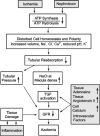Adenosine receptors and the kidney
- PMID: 19639291
- PMCID: PMC6027627
- DOI: 10.1007/978-3-540-89615-9_15
Adenosine receptors and the kidney
Abstract
The autacoid, adenosine, is present in the normoxic kidney and generated in the cytosol as well as at extracellular sites. The rate of adenosine formation is enhanced when the rate of ATP hydrolysis prevails over the rate of ATP synthesis during increased tubular transport work or during oxygen deficiency. Extracellular adenosine acts on adenosine receptor subtypes (A(1), A(2A), A(2B), and A(3)) in the cell membranes to affect vascular and tubular functions. Adenosine lowers glomerular filtration rate by constricting afferent arterioles, especially in superficial nephrons, and thus lowers the salt load and transport work of the kidney consistent with the concept of metabolic control of organ function. In contrast, it leads to vasodilation in the deep cortex and the semihypoxic medulla, and exerts differential effects on NaCl transport along the tubular and collecting duct system. These vascular and tubular effects point to a prominent role of adenosine and its receptors in the intrarenal metabolic regulation of kidney function, and, together with its role in inflammatory processes, form the basis for potential therapeutic approaches in radiocontrast media-induced acute renal failure, ischemia reperfusion injury, and in patients with cardiorenal failure.
Figures




Similar articles
-
Adenosine and kidney function.Physiol Rev. 2006 Jul;86(3):901-40. doi: 10.1152/physrev.00031.2005. Physiol Rev. 2006. PMID: 16816141 Review.
-
Role of adenosine in renal protection induced by a brief episode of ischemic preconditioning in rats.Jpn J Pharmacol. 2001 Oct;87(2):134-42. doi: 10.1254/jjp.87.134. Jpn J Pharmacol. 2001. PMID: 11700012
-
Methylxanthines and the kidney.Handb Exp Pharmacol. 2011;(200):391-412. doi: 10.1007/978-3-642-13443-2_15. Handb Exp Pharmacol. 2011. PMID: 20859805 Free PMC article. Review.
-
Regional vascular responses to ATP and ATP analogues in the rabbit kidney in vivo: roles for adenosine receptors and prostanoids.Br J Pharmacol. 2006 Nov;149(5):523-31. doi: 10.1038/sj.bjp.0706901. Epub 2006 Sep 18. Br J Pharmacol. 2006. PMID: 16981003 Free PMC article.
-
Adenosine receptors and renal ischaemia reperfusion injury.Acta Physiol (Oxf). 2015 Jan;213(1):222-31. doi: 10.1111/apha.12402. Epub 2014 Oct 27. Acta Physiol (Oxf). 2015. PMID: 25287331 Free PMC article. Review.
Cited by
-
Pharmacomicrobiology of Methotrexate in Rheumatoid Arthritis: Gut Microbiome as Predictor of Therapeutic Response.Front Immunol. 2021 Dec 16;12:789334. doi: 10.3389/fimmu.2021.789334. eCollection 2021. Front Immunol. 2021. PMID: 34975886 Free PMC article. Review.
-
Sex Dependence in Control of Renal Haemodynamics and Excretion in Streptozotocin Diabetic Rats-Role of Adenosine System and Nitric Oxide.Int J Mol Sci. 2024 Jul 13;25(14):7699. doi: 10.3390/ijms25147699. Int J Mol Sci. 2024. PMID: 39062939 Free PMC article.
-
Urinary metabolomic analysis to detect changes after intravenous, non-ionic, low osmolar iodinated radiocontrast for computerized tomographic imaging.West J Emerg Med. 2014 Mar;15(2):152-7. doi: 10.5811/westjem.2013.11.15343. West J Emerg Med. 2014. PMID: 24672603 Free PMC article.
-
The multifaceted role of the renal microvasculature during acute kidney injury.Pediatr Nephrol. 2016 Aug;31(8):1231-40. doi: 10.1007/s00467-015-3231-2. Epub 2015 Oct 22. Pediatr Nephrol. 2016. PMID: 26493067 Free PMC article. Review.
-
Population Pharmacokinetics of Caffeine in Neonates with Congenital Heart Disease and Associations with Acute Kidney Injury.J Clin Pharmacol. 2024 Mar;64(3):300-311. doi: 10.1002/jcph.2382. Epub 2023 Nov 22. J Clin Pharmacol. 2024. PMID: 37933788 Free PMC article.
References
-
- Abizaid AS, Clark CE, Mintz GS, Dosa S, Popma JJ, Pichard AD, Satler LF, Harvey M, Kent KM, Leon MB. Effects of dopamine and aminophylline on contrast-induced acute renal failure after coronary angioplasty in patients with preexisting renal insufficiency. Am J Cardiol. 1999;83:260–263. A5. - PubMed
-
- Agmon Y, Dinour D, Brezis M. Disparate effects of adenosine A1- and A2-receptor agonists on intrarenal blood flow. Am J Physiol. 1993;265:F802–F806. - PubMed
-
- Arend LJ, Thompson CI, Spielman WS. Dipyridamole decreases glomerular filtration in the sodium-depleted dog. Evidence for mediation by intrarenal adenosine. Circ Res. 1985;56:242–251. - PubMed
-
- Arend LJ, Bakris GL, Burnett JC, Jr, Megerian C, Spielman WS. Role for intrarenal adenosine in the renal hemodynamic response to contrast media. J Lab Clin Med. 1987;110:406–411. - PubMed
-
- Bagshaw SM, Ghali WA. Theophylline for prevention of contrast-induced nephropathy: a systematic review and meta-analysis. Arch Intern Med. 2005;165:1087–1093. - PubMed
Publication types
MeSH terms
Substances
Grants and funding
LinkOut - more resources
Full Text Sources
Other Literature Sources

